Running watches can make all the difference to your training, providing detailed insights into performance and the ability to easily track trends over time. The only real problem is deciding which one is best for your needs.
Whether you’re just getting started with the Couch to 5K program or training intensively for your next marathon, in our experience, a reliable running watch can make it much easier to keep track of and ultimately achieve your goals.
But, with so many different options to choose from, some of which can cost in excess of £1000/$1000, knowing which one to go for can be difficult – even for the most seasoned of runners.
This is especially true based on our experience. There are plenty of running watches doing the rounds in 2023 that look great, but fail to deliver on key elements like tracking accuracy and battery life in real-world testing.
On top of that, if you just want a basic watch to track your treadmill runs or the odd 5km, you certainly don’t need to spend hundreds on a running watch. Many of the cheaper fitness trackers offer more than enough features to accommodate this kind of casual exercise.
Safe to say it can be confusing – but that’s where the expert team at Trusted reviews comes in. We’ve created this guide detailing the best options we’ve tried and tested to make sure you get the right running watch for your needs and budget.
Every watch on this list has been used by one of our reviewers for at least a week, tracking indoor and outdoor runs to gauge its performance, accuracy and battery life, so you can trust our buying advice.
On the off chance you don’t find what you’re looking for you can also check out our best smartwatch, best fitness tracker and best Garmin Watch guides, which offer further buying advice.
Best running watch at a glance
How we test
Every running watch we test is used by the reviewer for at least a week – or longer, if the battery life lasts beyond that point or we need more time to trial its features. During testing, we evaluate key metrics including app support, usability, battery life, and the accuracy of fitness and distance tracking.
For distance tracking, we assess how accurately the device records runs on tracks we know the length of. We also evaluate the level of battery life lost per hour using features such as built-in or connected GPS. To check heart rate accuracy, we compare the results from the wearable to a dedicated HRM strap.
Next, we combine the data recorded with our general experience of using the wearable day-to-day, revealing whether the device proved comfortable to wear, alongside any issues we may have encountered with unexpected bugs over the review period.
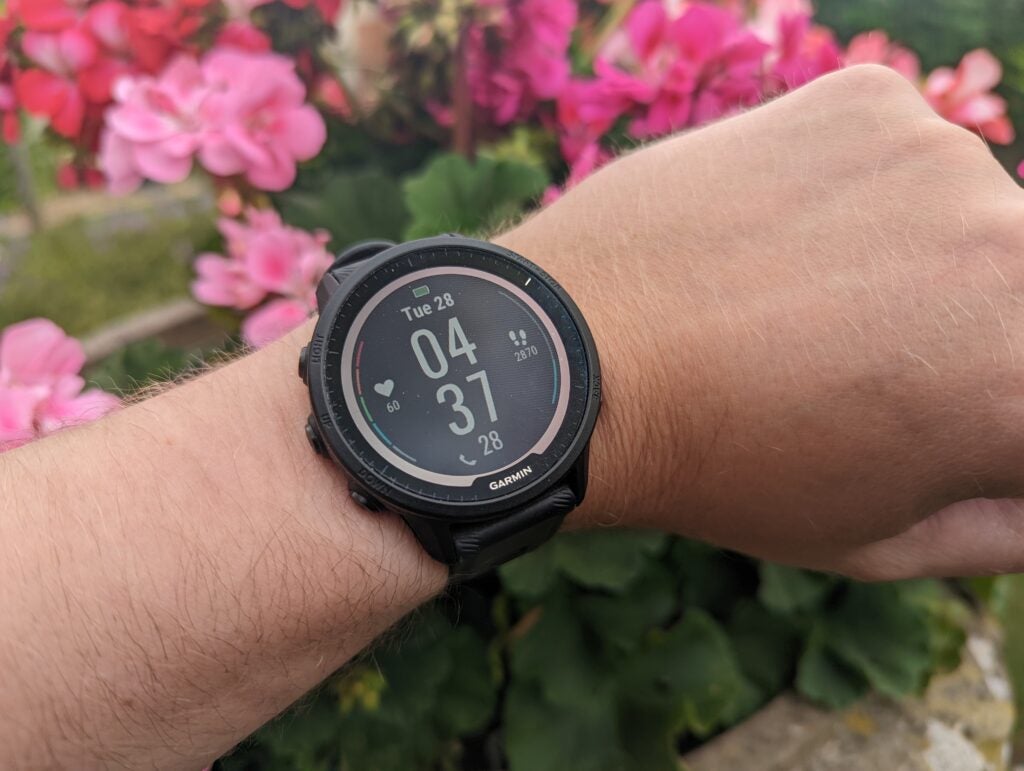
Garmin Forerunner 955 Solar
The best for serious runners and athletes
Pros
- Snappy and accurate multi-band GPS connectivity
- Comfortable discrete design
- Local music playback
Cons
- Limited smartwatch functionality
If you hop over to our best Garmin Watch of best fitness tracker guides, you’ll see the Garmin Fenix 7 is the best “top end” option we recommend for serious athletes. But, if you’re not interested in a tracker for extreme sports or only care about running specifically, then the Forerunner 955 is actually a better option.
Despite costing less than the baseline Fenix 7 it actually shares a lot of the same features and a few exclusives missing on its more premium sibling that during our tests made it as, if not better, for runners.
For starters, the device is a lot smaller, featuring a 1.3-inch transflective touch screen and chassis that’s a few millimetres thinner than what you find on the Fenix. This made it much more comfortable to wear during longer runs, and day-to-day for our reviewer, who was actually using the Fenix 7 as his daily tracker prior to reviewing the 955.
On top of that, it provides the same multi-band GPS support as the Fenix. This meant location tracking was accurate throughout testing and we never had any issues finding a GPS connection.
Add to this the same local music playback and local maps support and it became an easy recommendation. These are two key features that let you get guided, turn-by-turn directions on routes you’re not familiar with. The local music also let our tester enjoy a soundtrack to their run without needing to bring their phone along.
But what really sets it apart is its post-run analytics and coaching features. Unlike the Fenix and many other trackers, as well as distance, heart rate and training effect (which tells you how effective your last activity was) the device has a few useful add-on features. Our favourite was its training readiness service. Training readiness is an add-on that tells you how prepared your body is for a race or run.
The feature flags causes for lower scores, like poor sleep and offers active recommendations about how to get race ready. As an added bonus, the watch also factors races you’ve put into your calendar into its daily recommendations, making it easier to avoid overtraining ahead of the big event.
This plus the week-long battery life we enjoyed reviewing it, makes the Forerunner 955 the best option we’d recommend to any serious runner or racer at the moment. The only reason we recommend the Fenix 7 over it for more generalist or adventurous athletes is the fact that it has a plastic, not metal, chassis. This plus the lack of a Sapphire Glass option means it’s not as rugged as the Fenix and a less reliable option for climbers, watersports and extreme sports athletes.
Reviewer: Alastair Stevenson
Full review: Garmin Forerunner 955 review
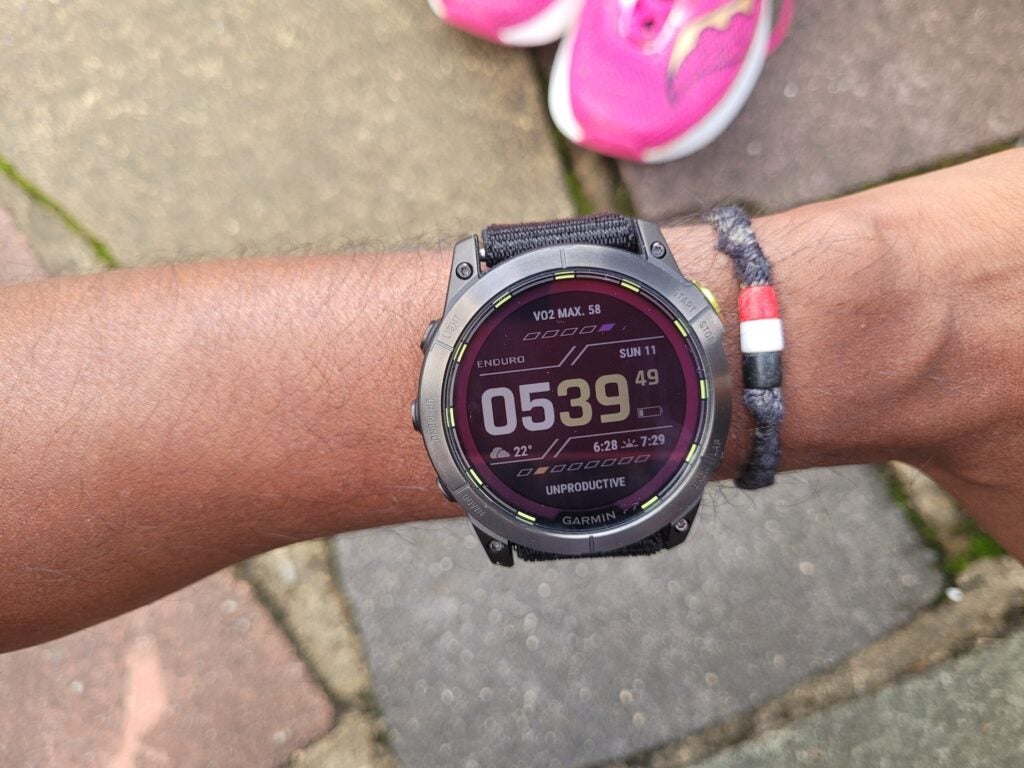
Garmin Enduro 2
The best for battery life
Pros
- Full-colour mapping added
- New Multi-band mode boosts tracking accuracy
- Slightly refined design
Cons
- Expensive
- Design will still be big for some
- Smartwatch battery numbers are down
The Enduro 2 is Garmin’s latest wearable for extreme runners. It’s also one of its most expensive. The Enduro 2 differentiates itself from the other watches on this list with its overt focus on battery life above all else.
Garmin’s designed it to offer up to 46 days of use as a smartwatch (with solar) and up to 150 hours GPS battery life (with solar). During testing we easily managed to get 3.5 weeks of heavy use out of the wearable. This included daily 5km runs with the GPS on and 10km’ jogs over the weekend.
Add to this its near indestructible design, healthy portfolio of fitness and health analytics, which are identical to what you get on the Fenix 7, accurate distance tracking and local mapping support, and the Enduro 2 becomes an easy recommendation for hardcore runners.
The only real downside is that you have to pay a real premium to get the battery life with it costing significantly more than the Fenix 7. As a result, we recommend most runners, that don’t need 150 hours of GPS tracking, to opt for the cheaper Fenix 7.
Reviewer: Michael Sawh
Full review: Garmin Enduro 2 Review
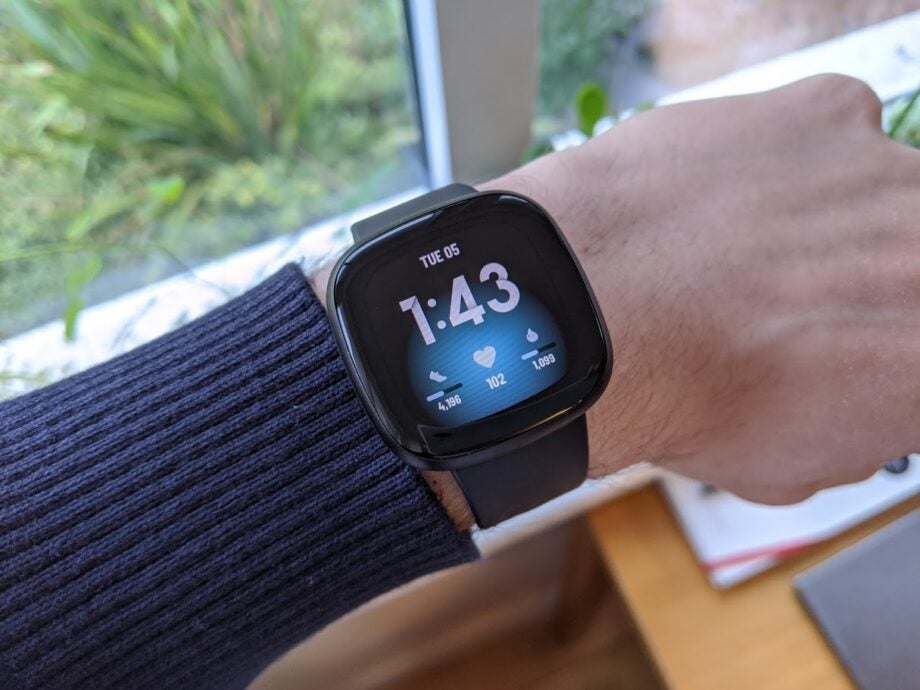
Fitbit Versa 3
Best entry-level running watch
Pros
- Feature-packed for the price
- GPS is finally here
- Six-day battery with intensive use
Cons
- Fitbit’s apps and app store still need work
- The step count is just too eager
- Still no support for offline Spotify
- Fitbit Premium is essential for getting your money’s worth
If you’re a newbie runner who’s just starting out then the Fitbit Versa 3 is currently our recommended affordable running watch. For less than $200 we found it offers a wonderfully competitive feature set that includes all the bells and whistles any new runner will need to reduce their 5km times.
On test we found the device atypical to most of the sub-$200 running watches we’ve reviewed in a couple of ways. For starters, it looks very like an Apple Watch, featuring a pebble-shaped square screen. Second, it actually comes with built-in GPS. Both are rare features on a watch at this price, putting the Fitbit Versa 3 above competing band-design trackers. Most affordable trackers – such as the Vivosmart 5 that we reviewed recently – rely on connected GPS.
While the Versa 3’s GPS connection speeds don’t match those of any other wearables on this list, the fact that the device lets you track distance without you having to take your phone with you is a definite bonus. Tracking itself was also pretty uniform, with the device throwing up anomalies only in city areas, where tall buildings interrupted the GPS connection. Heart rate tracking proved solid, too, with issues thrown up only with rapid spikes – during a particularly nasty test route, for example, that featured a very tall hill.
The only serious drawback is that, unlike the Polar and pretty much every other wearable on this list, the Fitbit locks some of the more advanced post-run analytics behind a paywall. Thankfully, this isn’t a deal-breaker; the free data on offer is robust and sufficiently detailed for newbies and more casual runners. However, it’s a reason we recommend more serious athletes invest a little more and pick up the Polar instead.
Reviewer: Thomas Deehan
Full review: Fitbit Versa 3 Review
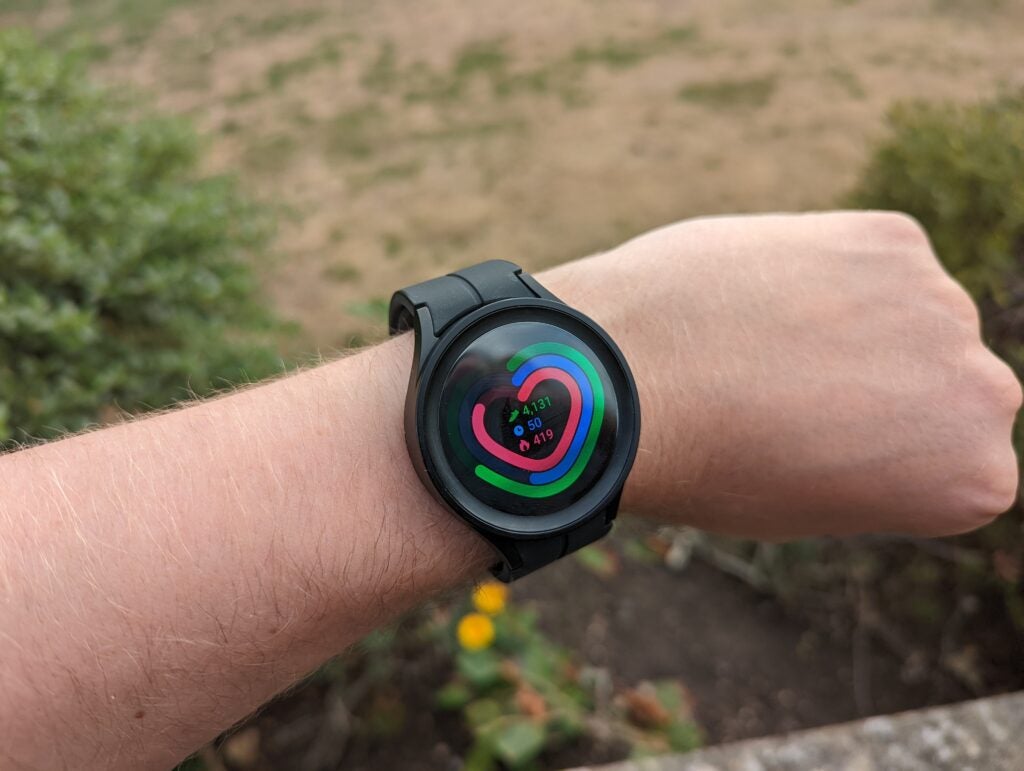
Samsung Galaxy Watch 5 Pro
Best for Wear OS
Pros
- Solid fitness tracking services
- Rugged, sports-ready design
- Wonderfully bright display
Cons
- Route planning process feels clunky
- Battery life doesn’t match rival fitness trackers
The Galaxy Watch 5 Pro is the best option for runners that want a full-functioning smartwatch too. The tracker is powered by Wear OS and that means you’ll find a much more developed application library than any of the other trackers on this list. Of course, you need an Android phone for this device, so it’s also for people who don’t have an iPhone.
There’s support for all the major running ecosystems including Strava, Runkeeper, my Fitness Pal and Samsung Health.
On top of that, you’ll get Spotify support and reliable GPS that, during our tests, proved wonderfully fast and reliable.
The rugged watch impressed when it came to analytics. The Samsung Health app offers detailed breakdowns of your running performance. These include common metrics, like how long you spent in each heart rate zone as well as more detailed ones like contact time and stiffness. It was the latter that helped our reviewer identify issues with his technique and will prove especially useful to other runners.
The only real downside to the watch compared to some of the other options on this list, like the Forerunner 955, is that the Watch 5 Pro has a distinctly shorter battery life. Like many smartwatches, our reviewer never managed to get three days of regular use out of the device.
It’s also slightly annoying that despite supporting GPX route planning, the feature doesn’t support running. Instead it’s limited to cycling and hiking. But if you want a proper smartwatch as well as a running companion and don’t like the look of Apple’s then this is the best option available.
Reviewer: Alastair Stevenson
Full review: Samsung Galaxy Watch 5 Pro review
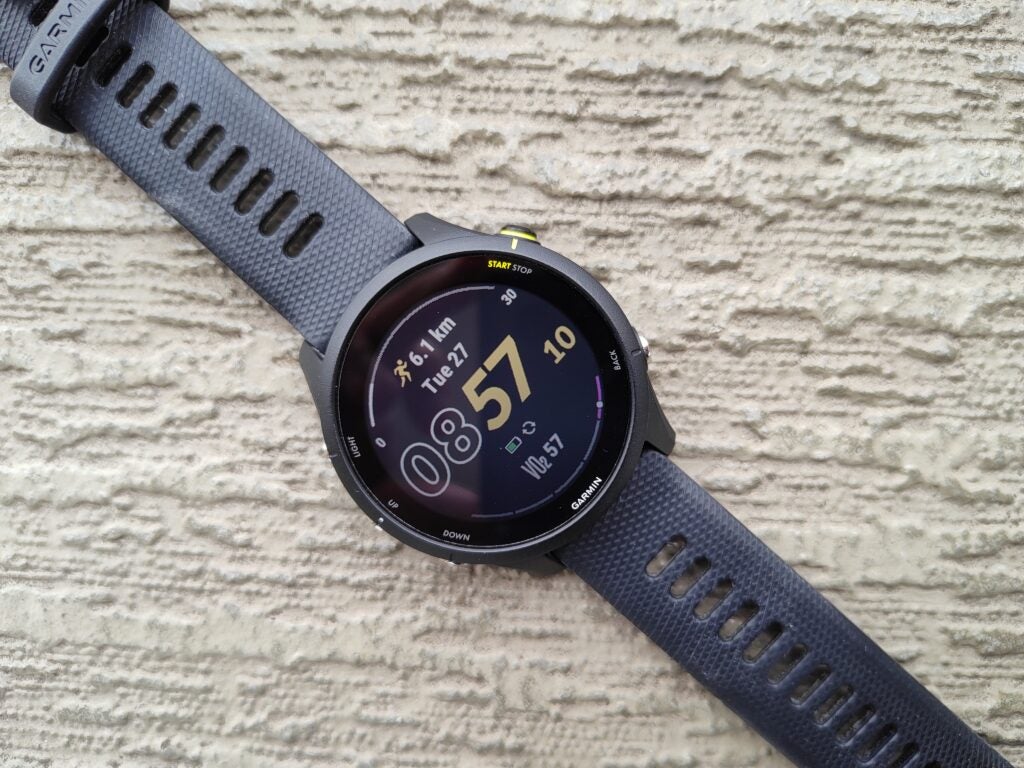
Garmin Forerunner 255
Best mid-level running watch
Pros
- Reliable fitness tracking
- Accurate health metrics
- Practical, lightweight design
- Good battery life
Cons
- Few smart features
- Unspectacular screen
If you’re a confident runner who wants a reliable and accurate running watch – but you don’t need all the extra bells and whistles of the top-end variants – then our recommendation is the Garmin Forerunner 255.
Despite its mid-range price point, this wearable offers a great range of fitness metrics, not just offering highly accurate readings from its 24/7 heart rate sensor and GPS, but also measuring your SpO2, VO2 Max, and delivering reliable sleep monitoring too. You’ll find that this wearable works as an excellent companion whether you’re just tracing your running routes or as a day-to-day fitness tracker.
What’s more, this wearable is water resistant up to 5ATM, and it has long-lasting battery life that will get you through a busy week on a single charge.
While you might not have all the smartwatch accoutrements offered by all-round devices, and it may not look as flashy as some of its rivals, this delivers where it matters for runners, giving you an excellent and balanced picture of your fitness progress.
Reviewer: Peter Phelps
Full Review: Garmin Forerunner 255 review
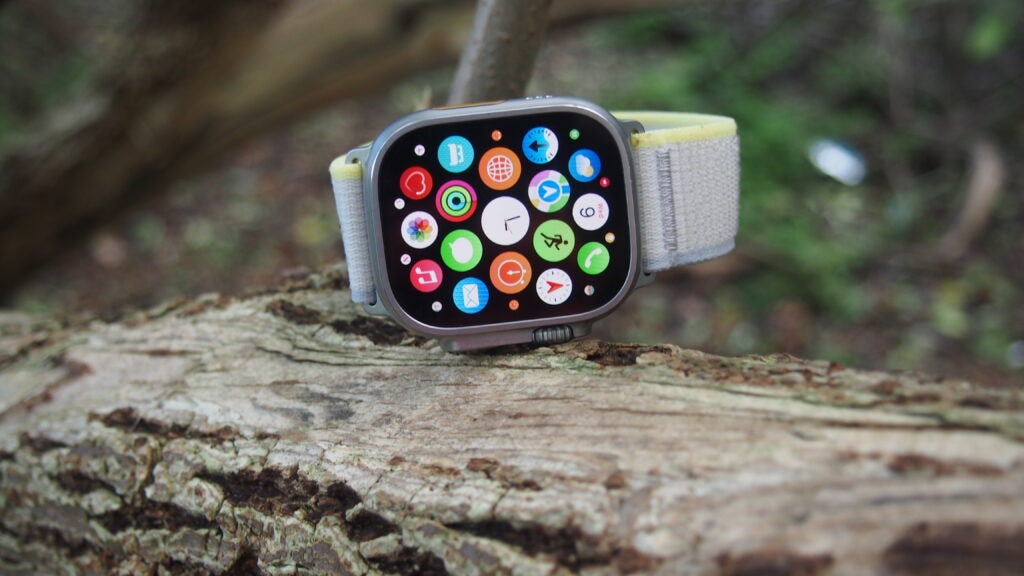
Apple Watch Ultra
Best for watchOS
Pros
- Improved battery on previous Apple Watches
- Surprisingly light design
- Good sports tracking performance
- Bigger, brighter Retina display
Cons
- It’s not cheap
- Design could be sleeker
- Some outdoor features are a work in progress
- New straps are a mixed bag
If you’ve been seduced by the sheer smoothness of Apple’s software, then the Apple Watch Ultra is your best bet for a reliable running watch that can see you through all weathers.
The construction quality of this wearable is far more rugged than the regular Apple Watch Series 8, given that the case is made from titanium and the screen is of sapphire crystal – in fact it’s even been tested to the MIL-STD-810H military standard for toughness, so you can rest assured that it will deal with whatever is thrown at you on the trail.
We also found the dual-band GPS to be very accurate, even when dealing with weaving around the notoriously challenging high-rise buildings that dominate the Chicago marathon. It held up as well as a high-end Garmin watch, so you can trust this to give you fairly accurate results when tracking the distance of your runs.
Furthermore, battery life is sufficiently strong though not brilliant by this category’s standards; it can get through 36 hours in normal mode, 60 hours in power-saving mode, and that aforementioned marathon took just over 20% of our charge after three and a half hours.
However, there are still a couple of minor teething problems with this all-new watch. For one thing, the strap isn’t as comfortable as we’d like, and for another there were some inaccuracies in the heart rate readings when near our maximum effort, as measured compared to a chest strap.
Nonetheless, if you need a rugged running watch that still has all the creature comforts of Apple’s excellent wearables software, then this is the one to plump for.
Reviewer: Michael Sawh
Full review: Apple Watch Ultra
Coros Apex 2
Best for durability
Pros
- Top-tier titanium and Sapphire build
- Small face but great screen clarity
- Good battery life
- Sufficient number of advanced fitness features
Cons
- On-watch maps are of limited use
- Crown-led navigation can feel clunky
- Some issues with early workout HR reliability
Garmin and Fitbit may be the go-to reference points in the public discourse surrounding fitness trackers and running watches but Coros has been gradually making a case for its own line of wearables and the Coros Apex 2 shows exactly why the company is a force to be reckoned with.
For starters, the Apex 2 features a part-titanium chassis with a robust sapphire display, both of which are rare for wearables around the same price point. What this means is that if you’re the type of person who worries about getting scratches on their smartwatch or accidentally knocking the device during a workout, then the Apex 2 can give you peace of mind with the ability to withstand a fair amount.
As great as the watch’s durability is, it’s not the only reason why you should consider it over a Garmin. In accordance with the Coros app, the Apex 2 can offer up a near dizzying amount of metrics and you can also programme a workout routine on your phone which is then ready to be viewed whenever you need on your wrist.
All of these metrics don’t come at the cost of battery life either, as the Apex 2 can still manage to crack on for up to 17-days on a single charge, making it ideal for anyone looking to head off on a long hike.
Part of that outstanding battery life is owed to the transflective LCD screen which, even though it isn’t quite as snazzy as an AMOLED display, is by its very nature easier to read outdoors which is exactly what you want when out on a run.
The key issue holding the Apex 2 back from greatness is the on-the-watch map system which just isn’t as intuitive or easy to populate as it is on Garmin devices. If you already know the routes that you plan on running however then this won’t be much of an issue.
Reviewer: Andrew Williams
Full review: Coros Apex 2
FAQs
GPS lets your watch track the distance you run as well as location. If you plan to use the watch to run outdoors then we’d recommend investing in a tracker with the technology.
Not all running watches are fully waterproofed. If you need one that can survive under water you should invest in one with an ATM or IP rating. These are certifications that what depths and lengths of time a device can survive underwater.
Comparison specs
You can see detailed breakdown of the core specs of all the running watches included in this list. The main thing to look out for is their GPS support, if they have local music playback and key extras, such as a SpO2 sensor.




